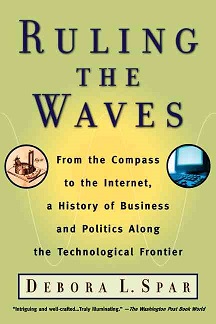This is a continuation of an earlier post where I started reviewing the book Ruling the Waves, by Debora L. Spar, specifically attempting to tie the author’s thesis in with saecular theory. In that post I only got as far as the first technological wave, the telegraph. In this post I’ll cover the next two waves – radio and the late twentieth-century advancements in television. First, let’s recap the thesis of Spar’s book, summarized in my first post.
The author has a premise that when a ground-breaking new technology is introduced, it goes through four phases of development before becoming a commonplace part of everyday life on which we depend. First there is the invention phase, involving just a few people, and then the entrepreneur phase, where risk-takers develop the new technology commercially. Next is what she calls a period of “creative anarchy,” when the most successful entrepreneurs battle for supremacy in the marketplace, and finally the rulemaking phase, where those who now dominate the technology application push for a fixed legal structure within which to operate.
Now, when looking at the telegraph, it was fairly easy to align the development of the technology with the turnings of the Civil War Saeculum. The invention phase happens at the end of the second turning, the entrepreneurial and market free-for-all phases during the third turning leading up to the Civil War, and then the rule-making period comes with the rise of Western Union during Reconstruction and the Gilded Age.
The next two waves, as described by Spar, are a little more compressed in time. The story of radio comes in two halves. The first one is dominated by the best known figure in the history of radio, Guglielmo Marconi (b. 1874 – Missionary peer). He was not just an inventor, but also an entrepreneur, and managed not only to make radio a feasible technology, but also to completely control the market via his patents during the 1910s.
But Marconi’s dominance was undermined by two factors. The first was nation-state governments, which recognized the security implications of wireless communication and used their authority to constrain Marconi’s monopoly power. The second factor was the development of the next generation of radio technology. Marconi’s system used spark gaps to generatate pulses of electricity and transmit signals in Morse code – it was essentially wireless telegraphy. What was really wanted was a way to send signals on continuous waves. Then sound, even music, could be transmitted. It would transform radio into wireless phonography, which is how we experience it today.
This is the second half of the radio story, a sort of mini-wave of its own. The invention phase was primarily the work of an engineer named Reginald Fessenden (b. 1866 – Missionary), and occurred at the same time that Marconi’s creation was prominent. The entrepreneurial/creative anarchy phase took place in the first part of the 1920s. It was kicked off by an important development, the formation of the Radio Corporation of America (RCA) in 1919. This was an innovation of its own in the commercialization of communications – RCA was an organization that controlled radio stations without controlling the technology of radio. This was the beginning of the broadcasting industry. Marconi’s system became obsolete and his patents worthless, and his empire crumbled.
In the first half of the 1920s, radio was in a period that definitely matches Spar’s creative anarchy phase in technology develoment. Small stations operated by amateurs – “radioheads” – sprung up everywhere, broadcasting whatever music they could get their hands on. This became too chaotic to be tenable, since by their very nature broadcast signals interfere with one another. Order came with laws passed in the late 1920s to regulate bandwidth, and with the emergence of broadcasting corporations which controlled networks of radio stations and could operate them in a coordinated fashion. The first of these was the National Broadcasting Corporation (NBC), and before long ABC and CBS came along – the Big Three which moved on to the world of television broadcasting and which are still prominent today.
So Spar’s entire cycle of four phases of technology development can actually fit into the space of one decade. The fact that radio’s story is ensconced within the third turning of the Great Power saeculum fits that era’s heady, fast-paced reputation. The subsequent development of television takes place in the next first turning, but Spar actually skips over that entirely. Her example from the history of television specifically relates to the rise of satellite and digital TV.
This is another fast cycle, and takes place within the third turning of the current Millennial saeculum – in the 1990s, the last decade before the publication of Spar’s book. It starts with the rise of SkyTV, powered by the relentless ambition of Rupert Murdoch (b. 1931 – Silent). The new techonology in question was satellite broadcasting, and the key to SkyTV’s takeover of the British market was the fact that Britain’s tight television regulations did not cover this particular type of broadcasting.
By taking advantage of this regulatory gap, Murdoch was able to penetrate the British television market with a unique brand, one that threatened Britain’s conservative and cultured self-image with trashy “American-style” content. SkyTV quickly got into financial trouble, which Murdoch handled by bringing in legendary executive Sam Chisholm (b. 1939 – Silent peer). But no sooner had Chisholm straightened things out, than SkyTV was hit by a new wave of techonological innnovation and forced to adjust to that.
This new wave was digital broadcasting, which basically reimplements signal encoding in such a way that far more channels can fit within the same bandwidth of electromagetic radiation. Consequently, providers can offer more content and choices, to presumably leverage for more profit-making. You may remember this transistion, which for consumers was disruptive since it meant their old analog systems were going to become obsolete. You may remember complaining and a sense of consumer powerlessness in the face of inexorable progress. It’s a done deal now, but at the time that Spar’s book was published was an ongoing process of negotiation and new rulemaking.
What’s interesting about these different techonological waves is that as they progress across the twentieth century, “ruling the wave” becomes as much a matter of navigating the regulatory environment as of pioneering a new techonological application. This comes with the growing sophistication of both corporate enterprise and government oversight. But even as the focus of the stories has shifted from individual inventors and entrepreneurs to giant corporations and milestone regulatory acts, there is still room for strong personalities to exert their influence.
The last part of the book covers computer and Internet technology. I will finish reading it and conclude these reviews in a future post.






